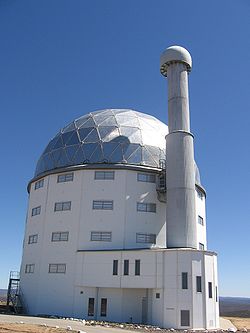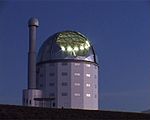- South African Astronomical Observatory
-
South African Astronomical Observatory 
The Southern African Large TelescopeOrganization National Research Foundation of South Africa Code 51, B31, A60 Location Headquarters in Observatory, Cape Town
Major telescopes in Sutherland, Northern CapeCoordinatesEstablished January 1972 Website
http://www.saao.ac.zaTelescopesSALT 11m reflector Radcliffe 1.9m reflector Infrared Survey Facility 1.4m reflector MONET 1.2m reflector Elizabeth 1m reflector SuperWASP-South 8x Canon 200mm f/1.8 ACT 75cm reflector South African Astronomical Observatory (SAAO) is the national center for optical and infrared astronomy in South Africa. It was established in 1972. The observatory is run by the National Research Foundation of South Africa. The facility's function is to conduct research in astronomy and astrophysics. The primary telescopes are located in Sutherland, which is 370 kilometres (230 mi) from Observatory, Cape Town, which is where the headquarters is located. [1]
The SAAO has international links worldwide that exchange scientific and technological collaboration. Contributions from the South African Astronomical Observatory to the science field include the development of a spherical aberration corrector and the Southern African Large Telescope, otherwise known as SALT.
The Noon Gun on Cape Town's Signal Hill is fired remotely by a time signal from the Observatory.
History
The history of the SAAO began when the Royal Observatory at the Cape of Good Hope was founded in 1820, the first scientific institution in Africa.[2] Construction of the main buildings were completed in 1829 at a cost of £30,000[3] (equivalent to £2.2 million in 2011[4]). The post of Her Majesty's astronomer at the Cape of Good Hope was awarded the Royal Medal on two occasions; the first to Thomas Maclear in 1869 for measurement of an arc of the meridian at the Cape of Good Hope[5] and the second to David Gill in 1903 for researches in solar and stellar parallax, and his energetic direction of the Royal Observatory at the Cape of Good Hope.[6]
During the 1970s, the Republic Observatory in Johannesburg and the Radcliffe Observatory in Pretoria merged with the much older Royal Observatory to form the South African Astronomical Observatory.
SAAO was established in January 1972 as a result of a joint agreement by the Council for Scientific and Industrial Research (CSIR) of South Africa and Science and Engineering Research Council (SERC) of United Kingdom. The headquarters are located on the grounds of the old Royal Observatory where the main building, offices, national library for astronomy and computer facilities are housed. Historic telescopes are also found at the headquarters in a number of domes and a small museum that displays scientific instruments. The South African Astronomical Observatory is administered as a National Facility under management of the National Research Foundation (NRF), now formerly Foundation for Research Development (FRD). In 1974, when the Radcliffe Observatory in Pretoria closed, the Royal Observatory and the Republic Observatory combined facilities. The Council for Scientific and Industrial Research (CSIR) purchased the 1.9 Radcliffe telescope and transported it to Sutherland.[7]
Facilities
The observatory operates from the ground of the Royal Observatory, Cape of Good Hope that was established in 1820[8] in the suburb of Observatory, Cape Town.
The major observing facilities are however located near the town of Sutherland some 370 kilometres (230 mi)[1] from Cape Town.
Telescopes (Cape Town)
McClean telescope
Also known as the Victoria telescope, this telescope is fitted with a 24 inches (61 cm) photographic objective and a 18 inches (46 cm) visual objective.[9][10] The telescope was built by Grubb and completed in 1897. It was officially opened on 10 September 1901 by Sir Walter Hely-Hutchinson.[10]
Phased Experimental Demonstrator (PED)
The PED was built by members of the Karoo Array Telescope team in order to gain experience in the construction of interferometric telescopes. It is located on the grounds of the SAAO Headoffice in Observatory, Cape Town and consists of six 2.5 metres (8.2 ft) and one 3.4 metres (11 ft) antennas suitable for work at 1.4 GHz.[11]
Telescopes (Sutherland)
0.50m telescope
This 0.5 metres (20 in) reflector was originally built for the Republic Observatory in 1967, but was moved to the Sutherland site in 1972.
0.75m telescope
A 0.75 metres (30 in) Grubb Parsons reflector.
Alan Cousins Telescope (ACT)
This 29.5 inches (75 cm) telescope was originally called the Automatic Photometric Telescope, but has been renamed the Alan Cousins Telescope in honour of Alan William James Cousins.[12][13]
BiSON
Main article: Birmingham Solar Oscillations NetworkOne of six telescopes in the Birmingham Solar Oscillations Network
Elizabeth Telescope
See also: Probing Lensing Anomalies NetworkThis 40 inches (1.0 m) telescope was originally located at SAAO Headoffice in Observatory, Cape Town, but has since moved to the Sutherland site.[14] This telescope participates in the PLANET network.[15]
Infrared Survey Facility (IRSF)
The IRSF is a 140 centimetres (55 in) reflector fitted with a 3 colour Infrared Imager.[16] Originally built as part of the Magellanic Clouds - A Thorough Study grant from the Japanese Ministry of Education, Culture, Sports, Science and Technology in 2000.[17] Other studies the telescope participated in include:
- The Indian Department of Space used this telescope for the Near Infrared Survey of the Nuclear Regions of the Milky Way in order to improve on data from the DENIS and 2MASS Astronomical surveys.[18]
MONET
One of the two 1.20 metres (47 in) telescopes of the MOnitoring NEtwork of Telescopes Project is located at Sutherland, its twin can be found at the McDonald Observatory in Texas.[19] The MONET telescopes are Robotic telescope controllable via the Internet and was constructed by the University of Göttingen.[20] Remote Telescope Markup Language is used to control the telescopes remotely.[21]
Radcliffe Telescope
Not to be confused with the Radcliffe 18/24-inch Double Refractor at the University of London Observatory.The 1.9 metres (75 in) Radcliffe Telescope was commissioned for the Radcliffe Observatory in Pretoria and was operated between 1948 and 1972. In 1972 it was moved to Sutherland. Between 1951 and 2004 it was the largest telescope in South Africa.[22]
Southern African Large Telescope (SALT)
Main article: Southern African Large Telescope- Observatory Code: B31
- Observations: (Near Earth Objects)
SALT was inaugurated in November 2005. It is the largest single optical telescope in the Southern Hemisphere, with a hexagonal mirror array 11 meters across. SALT shares similarities with the Hobby-Eberly Telescope (HET) in Texas. The Southern African Large Telescope gathers twenty-five times as much light as any other existing African Telescope.[23] With this larger mirror array, SALT can record distant stars, galaxies and quasars.
SuperWASP-South
Main article: SuperWASPSee also: List of extrasolar planetsThe Wide Angle Search for Planets consists of two robotic telescopes, the one located at SAAO Sutherland and the other at Roque de los Muchachos Observatory on the island of La Palma in the Canaries.[24] WASP-17b, the first exoplanet known to have a retrograde orbit was discovered in 2009 using this array.
KELT-South
KELT-South (Kilodegree Extremely Little Telescope - South) is a small robotic telescope that is designed to detect transiting extrasolar planets. The telescope is owned and operated by Vanderbilt University and was based on the design of KELT-North, which was conceived and designed at the Ohio State University, Department of Astronomy. The KELT-South telescope will serve as a counterpart to its northern twin, surveying the southern sky for transiting planets over the next few years.
Yonsei Survey Telescopes for Astronomical Research (YSTAR)
- Observatory Code: A60
- Observations: (Near Earth Objects)
Used for the monitoring of variable stars and other transient events. This telescope is a joint project between SAAO and the Yonsei University, Korea.[20]
Geophysical
South African Geodynamic Observatory Sutherland (SAGOS)
The GeoForschungsZentrum, Potsdam in cooperation with the National Research Foundation of South Africa constructed the SAGOS between 1998 and 2000. SAGOS consist of a 1 Hz permanent GPS station, a superconducting gravimeter, meteorological sensors, and a tri-axial magnetometer. The GPS station is also used in support of the CHAllenging Minisatellite Payload (CHAMP) and Gravity Recovery and Climate Experiment (GRACE) space missions.[25]
SUR Station
The SUR station forms part of the International Deployment of Accelerometers Project and the Global Seismographic Network of the Incorporated Research Institutions for Seismology[26][27]
Further reading
- Royal Observatory, Cape of Good Hope, 1820-1831. Kluwer Academic Publishers. ISBN 9780792335276. OCLC 32465151.
- Gill, David. Heliometer observations for determination of stellar parallax made at the Royal Observatory, Cape of Good Hope (1893). Eyre and Spottiswoode. http://www.archive.org/details/heliometerobserv00gillrich. at the Internet Archive
- Wiehahn, Michelle (2002-02). "Using the SAAO Automatic Photometric Telescope to Study the Long-Term Lightcurves of Cataclysmic Variables". Submitted in partial fulfilment o the requirements for the degree of BSc Honours at the University of Cape Town. University of Cape Town - Department of Astronomy. http://mensa.ast.uct.ac.za/~pwoudt/Students/MichelleWiehahnBScHons2002.pdf.
See also
- National Research Foundation of South Africa
- Astronomical Society of Southern Africa
- Other optical observatories and telescopes in South Africa
- Radio observatories and telescopes in South Africa
- Magnetic observatories in South Africa
References
- http://www.saao.ac.za/
- http://www.nrf.ac.za/facilities/saao/
- http://www.salt.ac.za/public-info/milestones/first-light/
- http://www.salt.ac.za/public-info/milestones/inauguration/press-release/
- http://flickr.com/photos/pix_elate/2609507073/
Notes
- ^ a b "Additional information about SAAO Sutherland". South African Astronomical Observatory. http://www.saao.ac.za/public-info/visits/sutherland/sutherland-background/. Retrieved 3 October 2010.
- ^ Laney, Dave. "The South African Astronomical Obsrvatory: Africa's Eye In The Sky". South African Department of Science and Technology. http://www.dst.gov.za/publications-policies/magazine/m00003/volume-3-2. Retrieved 2009-01-30.
- ^ "THE TRANSIT OF VENUS.; THE EXPEDITION AT THE CAPE OF GOOD HOPE.". The New York Times. 1874-12-06. http://query.nytimes.com/gst/abstract.html?res=9A07EFDC173DE43BBC4E53DFB467838F669FDE. Retrieved 2011-07-16.
- ^ UK CPI inflation numbers based on data available from Lawrence H. Officer (2010) "What Were the UK Earnings and Prices Then?" MeasuringWorth.
- ^ "Royal archive winners before 1900". The Royal Society. http://royalsociety.org/page.asp?id=1753. Retrieved 2008-12-06.
- ^ "Royal Medal Winners:1949 - 1900". The Royal Society. http://royalsociety.org/page.asp?id=1752. Retrieved 2008-12-01.
- ^ Heck, Andre (2002). Organizations and Strategies in Astronomy III. pp. 160. ISBN 978-1-4020-0812-2.
- ^ Holden, Edward Singleton (1888). "The Principal Observatories of the World". Hand-book of the Lick Observatory of the University of California. pp. 112. http://www.archive.org/stream/handbookoflickob00holdrich#page/112/mode/1up/search/hope. Retrieved 2 October 2010.
- ^ A descriptive catalogue of the McClean collection of manuscripts in the Fitzwilliam Museum. 1912. pp. xvi. http://www.archive.org/stream/descriptivecatal00fitz#page/n21/mode/1up. Retrieved 2 October 2010.
- ^ a b "Victoria Telescope". Astronomical Society of Southern Africa. http://assa.saao.ac.za/html/his-tel-mcclean_victoria.html. Retrieved 2 October 2010.
- ^ "History of PED". Karoo Array Telescope. http://www.kat.ac.za/ped/about.html. Retrieved 4 January 2010.
- ^ "The Alan Cousins Telescope - Automatic Photometric Telescope". South African Astronomical Observatory. http://www.saao.ac.za/facilities/telescopes/act/. Retrieved 2009-01-29.
- ^ "Automatic Photometric Telescope (APT)". Astronomical Society of Southern Africa. http://assa.saao.ac.za/html/his-tel-apt-75c_30i.html. Retrieved 2009-01-29.
- ^ "The 40 inch Elizabeth telescope". South African Astronomical Observatory. http://www.saao.ac.za/facilities/telescopes/10m/introduction/. Retrieved 2009-01-28.
- ^ "It’s Far, It’s Small, It’s Cool: It’s an Icy Exoplanet! Distant Planet Brings Astronomers Closer To Home". http://www.phys.utas.edu.au/physics/optastr/media_OB390_files/esopr-03-06_v2.pdf. Retrieved 2009-05-15.
- ^ "IRSF telescope". South African Astronomical Observatory. http://www.saao.ac.za/assa/html/his-tel-irsf-1_4m_55i.html. Retrieved 2009-01-30.
- ^ Nagata, Tetsuya. "IRSF 1.4-m telescope continues providing wonderful images at SAAO". The Astronomical Herald 98 (3): 137–138. Bibcode 2005AstHe..98..137N. ISSN 0374-2466.
- ^ "Near Infrared Survey of the Galactic Nuclear Bulge Region". Bulletin of the Astronomical Society of India 31: 403. 2003. Bibcode 2003BASI...31..403B. http://prints.iiap.res.in/bitstream/2248/2485/1/paper-68.pdf.
- ^ "Research Facilities". McDonald Observatory. http://www.as.utexas.edu/mcdonald/facilities/facilities.html. Retrieved 2009-05-15.
- ^ a b "Telescopes". South African Astronomical Observatory. http://www.saao.ac.za/facilities/telescopes/. Retrieved 2009-01-30.
- ^ "Running MONET and SALT with Remote Telescope Markup Language 3.0". American Astronomical Society Meeting 202, #38.09; Bulletin of the American Astronomical Society, Vol. 35, p.753. 2003/05. http://adsabs.harvard.edu//abs/2003AAS...202.3809H. Retrieved 2009-05-15.
- ^ "Radcliffe 74-inch (1.9 m)". South African Astronomical Observatory. http://www.saao.ac.za/assa/html/his-tel-radcliffe-1_9m.html. Retrieved 2009-01-28.
- ^ "First Light". South African Large Telescope. http://www.salt.ac.za/public-info/milestones/first-light/. Retrieved 2009-05-15.
- ^ "Welcome to the WASP website". SuperWASP. http://www.superwasp.org/. Retrieved 2009-01-30.
- ^ "South African Geodynamic Observatory Sutherland (SAGOS)". Helmholtz Centre Potsdam GFZ German Research Centre for Geosciences. http://www.gfz-potsdam.de/portal/-;jsessionid=F0861E9D688B05E6141F79CB7EE42EEF?$part=CmsPart&docId=1644561. Retrieved 2009-01-30.
- ^ "Geophysical Facilities". South African Astronomical Observatory. http://www.saao.ac.za/facilities/geophysical-facilities/. Retrieved 2009-01-30.
- ^ "Station SUR, Sutherland, Republic of South Africa". Project IDA. http://ida.ucsd.edu/Stations/sur/. Retrieved 2009-01-30.
External links
 External images
External images
Photos of the dome of the Victoria telescope from the University of Cambridge Categories:- Astronomical observatories in South Africa
- 1820 in South Africa
Wikimedia Foundation. 2010.





